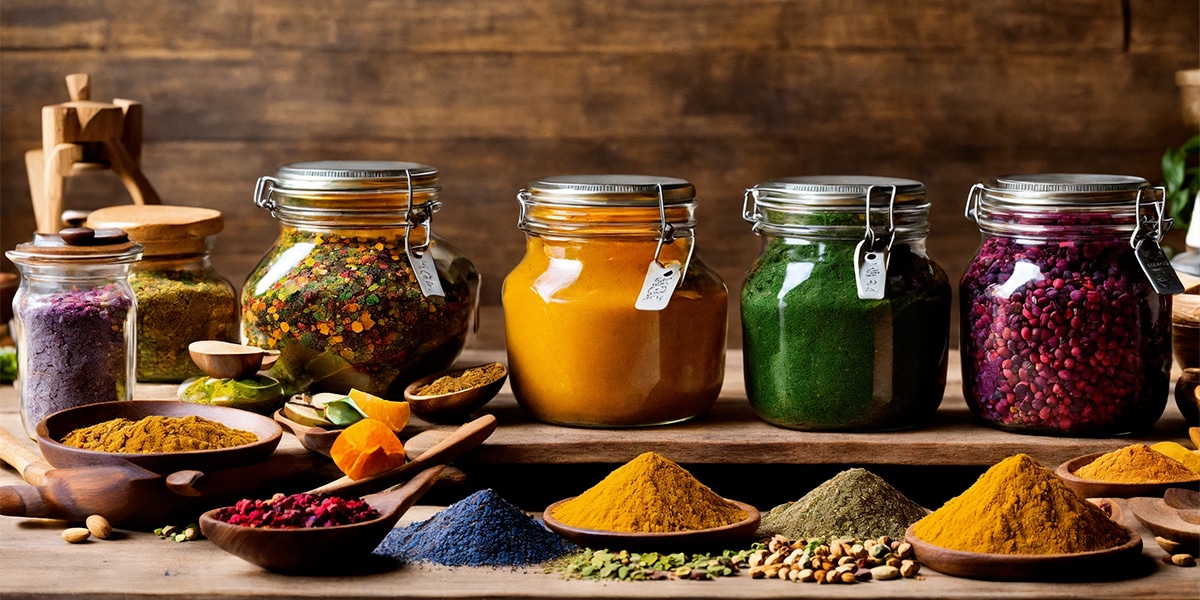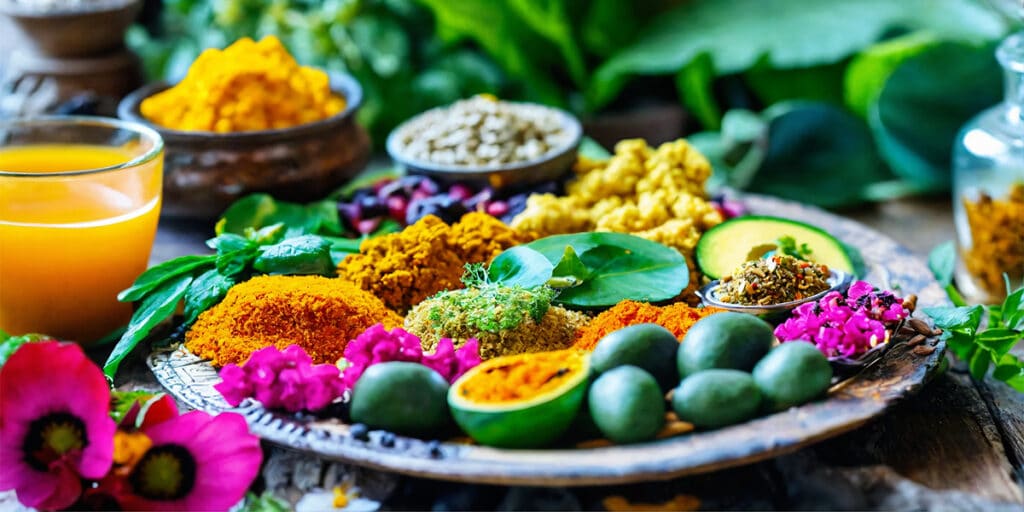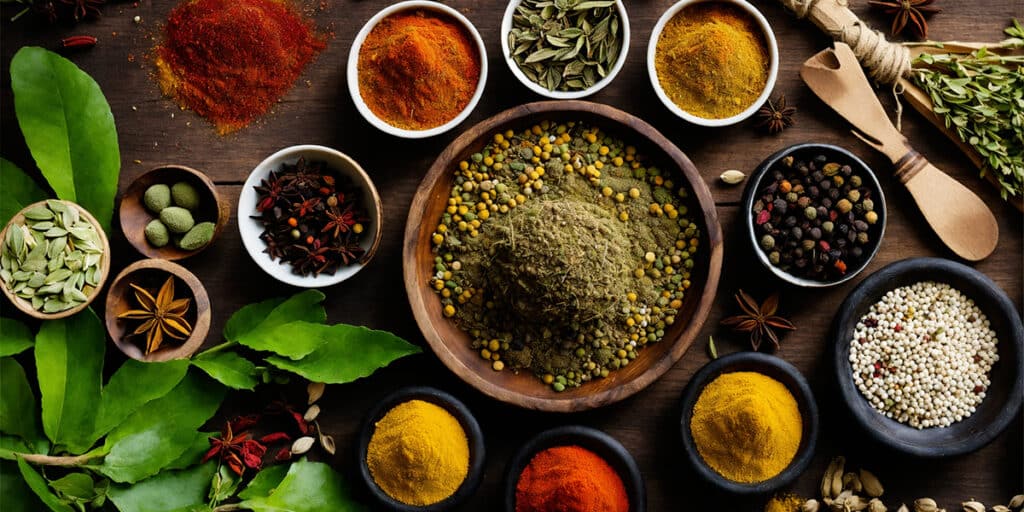In the modern quest for wellness, the ancient wisdom of Ayurveda has found a new resonance, especially among those navigating the complexities of diabetes management. This condition, marked by elevated blood sugar levels, has become a global health challenge, with lifestyle and dietary habits playing pivotal roles in its prevalence. Ayurveda, with its holistic approach, offers not just a path to manage diabetes but a lifestyle to transform it.
This article dives into the heart of Ayurvedic superfood blends, potent concoctions that promise to balance, heal, and rejuvenate your body from within, offering a natural adjunct to diabetes wellness.
The Power of Ayurvedic Superfoods in Diabetes Management
Ayurvedic superfoods are celebrated for their unique nutritional profiles, packed with antioxidants, anti-inflammatory compounds, and essential nutrients that support metabolic health and wellness. These superfoods include amla (Indian gooseberry), turmeric, moringa, fenugreek, and cinnamon—each bringing its own set of benefits to the table. Integrating these superfoods into daily dietary practices can enhance insulin sensitivity, regulate blood sugar levels, and mitigate the risk factors associated with diabetes.
The magic of these superfoods is not just in their individual properties but in their combined synergistic effects when blended. Ayurvedic tradition harnesses this power through specific blends that maximize their healing potential, making them more than just food; they are medicine for the body and soul.
Crafting Ayurvedic Superfood Blends
Creating effective Ayurvedic superfood blends involves understanding the properties of each ingredient and how they can complement each other. For instance, a blend combining amla, known for its high vitamin C content, with turmeric, a powerful anti-inflammatory, creates a potent mix that can help in reducing blood sugar levels and enhancing immune function.
- Amla is rich in chromium, which enhances insulin sensitivity.
- Turmeric contains curcumin, which has been shown to lower blood glucose levels and reduce inflammation.
- Moringa, another superfood, is packed with vitamins, minerals, and amino acids, aiding in blood sugar regulation.
- Fenugreek seeds, with their high soluble fiber content, slow down the absorption of carbohydrates, thus regulating blood sugar.
- Cinnamon, recognized for its ability to lower blood sugar levels, adds flavor and a host of health benefits to the blend.
Incorporating these blends into your daily routine can be as simple as adding them to smoothies, teas, or even meals, making it an effortless yet effective step towards diabetes wellness.
Superfood Blends and Scientific Evidence
Research underscores the efficacy of these superfoods in managing diabetes. Studies have highlighted:
- The role of amla in improving pancreatic function and insulin secretion.
- Turmeric’s effectiveness in reducing blood glucose levels and inflammation markers.
- Moringa’s potential in lowering fasting blood sugar levels in diabetic patients.
- Fenugreek’s impact on enhancing insulin sensitivity and lowering blood sugar levels.
- Cinnamon’s ability to improve fasting blood glucose and cholesterol levels.
These findings reinforce the power of integrating Ayurvedic superfood blends into a diabetes management plan, providing a natural way to complement medical treatments and lifestyle modifications.
| Superfood | Key Nutrients | Benefits for Diabetes |
|---|---|---|
| Amla (Indian Gooseberry) | High in Vitamin C, chromium | Enhances insulin sensitivity, reduces blood sugar levels |
| Turmeric | Curcumin, anti-inflammatory compounds | Lowers blood glucose and inflammation |
| Moringa | Vitamins, minerals, amino acids | Aids in lowering fasting blood sugar levels |
| Fenugreek | Soluble fiber, saponins | Improves insulin sensitivity, slows carbohydrate absorption |
| Cinnamon | Cinnamaldehyde, antioxidants | Improves fasting blood glucose, aids in cholesterol management |
Integrating Ayurvedic Superfood Blends into Your Daily Routine
Embracing Ayurvedic superfoods for diabetes wellness doesn’t just end with understanding their benefits; it’s also about seamlessly incorporating these power-packed nutrients into your daily life. Making these superfoods a part of your routine can transform your approach to managing diabetes, ensuring you’re nourishing your body with the right ingredients for optimal health.
Morning Start: Begin your day with a warm cup of herbal tea infused with cinnamon or turmeric. This not only kickstarts your metabolism but also helps regulate blood sugar levels right from the start.
Nutritious Smoothies: For breakfast or a mid-day snack, blend a smoothie with moringa powder, amla, and fenugreek seeds. These superfoods mixed with fresh fruits and vegetables create a nutrient-dense drink that supports blood sugar control and boosts your intake of vitamins and minerals.
Wholesome Meals: Incorporate fenugreek seeds into your cooking, whether it’s in the form of sprouted seeds in salads or powdered in curries. Using amla in pickles or as a part of your vegetable stir-fry can also enrich your meals with its health benefits.
Evening Relaxation: Wind down your day with a cup of herbal tea made from a blend of Ayurvedic herbs. This not only soothes the mind and body but also assists in managing blood sugar levels overnight.
By making these Ayurvedic superfoods a regular part of your diet, you’re not just addressing diabetes management but also enhancing overall well-being.
Ayurvedic Superfood Blends for Diabetes Wellness: Your FAQs Answered
Can Ayurvedic superfood blends cure diabetes?
No, they cannot cure diabetes but can significantly aid in managing the condition alongside conventional treatments.
How often should I consume these superfood blends?
Daily consumption is recommended, but it’s best to consult with a healthcare professional for personalized advice.
Are there any side effects?
These superfoods are generally safe, but it’s crucial to monitor blood sugar levels and consult a healthcare provider, especially if you’re on diabetes medication.
Can these blends replace diabetes medication?
No, they should be used as a complement to your medication, not a replacement. Always consult with your doctor before making any changes to your treatment plan.
Where can I find these superfoods?
Most health food stores or online markets carry these superfoods in various forms, including powders and whole seeds.
How can I incorporate these blends into my diet?
Adding them to smoothies, teas, or meals is an easy way to include them in your diet. Recipes and ideas abound in Ayurvedic cookbooks and wellness websites.
Will these blends help with weight loss?
While not a direct weight loss solution, their inclusion can support metabolic health and may aid in weight management as part of a balanced diet.
How quickly will I see results?
Effects can vary, but some people notice improvements in their blood sugar levels within a few weeks to months.
Can children with diabetes use these superfood blends?
Yes, but in moderation and under the guidance of a healthcare professional.
Are these superfood blends suitable for everyone?
While beneficial, individual conditions and allergies must be considered. Consultation with a healthcare provider is recommended.
Citations
- Amla (Indian Gooseberry) and Diabetes: Akhtar, M.S., Ramzan, A., Ali, A., & Ahmad, M. (2011). Effect of Amla fruit (Emblica officinalis Gaertn.) on blood glucose and lipid profile of normal subjects and type 2 diabetic patients. International Journal of Food Sciences and Nutrition, 62(6), 609-616. DOI: 10.3109/09637486.2011.560565.
- Turmeric’s Role in Diabetes Management: Chuengsamarn, S., Rattanamongkolgul, S., Luechapudiporn, R., Phisalaphong, C., & Jirawatnotai, S. (2012). Curcumin extract for prevention of type 2 diabetes. Diabetes Care, 35(11), 2121-2127. DOI: 10.2337/dc12-0116.
- Moringa Oleifera’s Impact on Blood Sugar Levels: Kumari, D.J. (2010). Hypoglycemic effect of Moringa oleifera and Azadirachta indica in type 2 diabetes. Biosciences Biotechnology Research Asia, 7(2), 577-582.
- Fenugreek and Its Antidiabetic Properties: Neelakantan, N., Narayanan, M., de Souza, R.J., & van Dam, R.M. (2014). Effect of fenugreek (Trigonella foenum-graecum L.) intake on glycemia: A meta-analysis of clinical trials. Nutrition Journal, 13, 7. DOI: 10.1186/1475-2891-13-7.
- Cinnamon for Glycemic Control: Allen, R.W., Schwartzman, E., Baker, W.L., Coleman, C.I., & Phung, O.J. (2013). Cinnamon use in type 2 diabetes: An updated systematic review and meta-analysis. Annals of Family Medicine, 11(5), 452-459. DOI: 10.1370/afm.1517.






